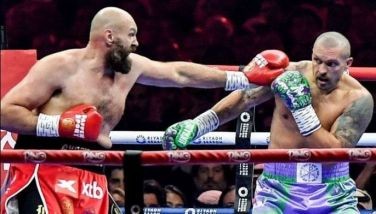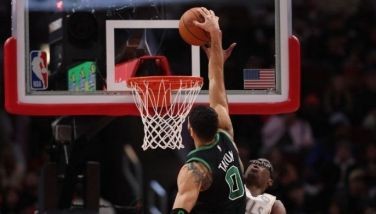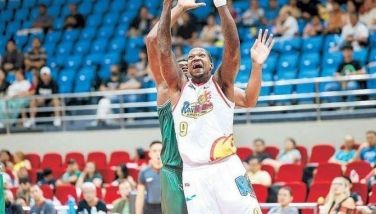Three’s a charm

November 26, 2006 | 12:00am
It’s almost as if Manny Pacquiao and Erik Morales were made for each other. In three fights, they slugged it out like there was no tomorrow, like their lives depended on winning — which is why fans described the series one of the most exciting boxing trilogies ever.
Pacquiao is destined to join Flash Elorde and Pancho Villa as the only Filipinos in the International Boxing Hall of Fame because of his exploits and achievements in the ring. He has captured the imagination of audiences all over the world with his devil-may-care style and infectious charisma.
Today, he is considered the most explosive fighter on earth and experts rate him one of the three best pound-for-pound pugilists (the others being Floyd Mayweather and Winky Wright).
In terms of titles, Pacquiao has won two — the World Boxing Council (WBC) flyweight crown and the International Boxing Federation superbantamweight diadem. When he stopped Marco Antonio Barrera, the General Santos City star was awarded the Ring Magazine featherweight belt as the "people’s champion." So in effect, Pacquiao has gained recognition as a three-division world champion, the only Asian to achieve the distinction.
By the way, ring announcer Michael Buffer erred in saying Pacquiao was formerly a superflyweight champion in introducing the fighter before the "Grand Finale." It wasn’t the only Buffer mistake that night. He called the WBC lightflyweight title bout between Omar Nino Romero and Brian Viloria as a fight for the miniflyweight throne.
Top Rank Promotions head Bob Arum said the first two Pacquiao-Morales fights generated pay-per-view sales amounting to a combined 700,000 hits. When the accounting is over, the rubber match should bring in at least 400,000. Ticket sales for the third fight hit the roof with an attendance of 18,276 — the second largest for a boxing event in Thomas and Mack Center history and the third biggest in Southern Nevada.
"They’re hyphenates," said boxing writer Bert Randolph Sugar of fighters involved in trilogies. "You almost can’t say Frazier without saying Ali. You can’t say Graziano without Zale. Frank Sinatra once had a song called ‘Love and Marriage.’ You can’t have one without the other. It’s like Gilbert and Sullivan. It’s like Cain and Abel. We tend not to remember any other of their goddam fights."
Trilogies unfold because the first two fights produce no clear trend in superiority. The third fight is usually a rubber match or the decider, the climax to cap a history of bad blood.
Take the feud between Muhammad Ali and Joe Frazier. Their showdown went to a third encounter, the so-called "Thrilla In Manila" in 1975 when Ali scored a dramatic 14th round stoppage. Ali and Smokin’ Joe never met again although they continued fighting other opponents. It was as if they wanted to preserve the memory of a great battle in the final episode of their trilogy.
"Some are convenience," said Sugar, referring to boxing trilogies. "Some are box office. And yes, some may be looking for revenge but it may not be revenge against the other person so much as for the loss on their resume."
Kieran Mulvaney, writing in espn.com, said: "One thing trilogies generally do have in common is that the first fight is almost always exciting, eventful or controversial enough to sustain the public desire for more, even if the return match is a relative disappointment — which in several cases (like Ali-Frazier, Gatti-Ward, Barrera-Morales) it has been. Jose Luis Castillo dominated Diego Corrales in their second fight last year, knocking him out in the fourth round. But in the first fight — in which Castillo had recovered from two 10th round knockdowns to stop Castillo in the same frame — had been so spectacular and the controversies surrounding the rematch (specifically, the fact that Castillo had not made weight and thus was perceived to have a physical advantage over Corrales) so mitigating that there remained the clamor for a decider and there would have been one had Castillo not failed to make weight again."
The first Pacquiao-Morales fight in March last year was far from decisive even as the Mexican walked away with a win via a unanimous decision. Pacquiao was cut above the eye in the fifth round and although referee Joe Cortez ruled it was opened by a punch, replays clearly showed a headbutt caused it. The three judges‚ scorecards were identical but only one round decided the outcome. If Pacquiao had won one more round, it would’ve gone down as a draw.
The second meeting was a barnburner. Morales led in the scorecards after five rounds but Pacquiao dominated the next five, dramatically ending the brawl with a 10th round stoppage. It was Morales’ first loss by knockout. Morales claimed Pacquiao never hurt him and blamed a weight reduction program for the setback.
So a third fight was a natural. Not only because Pacquiao and Morales wanted it to prove a point. Not only because Arum wanted it to deliver a blockbuster at the turnstiles and on pay-per-view TV. But primarily because the fans wanted it. In the end, the fans — not the fighters — determine the viability of a trilogy. Pacquiao and Morales owe them a huge debt of gratitude for the millions they earned from fighting each other.
Pacquiao is destined to join Flash Elorde and Pancho Villa as the only Filipinos in the International Boxing Hall of Fame because of his exploits and achievements in the ring. He has captured the imagination of audiences all over the world with his devil-may-care style and infectious charisma.
Today, he is considered the most explosive fighter on earth and experts rate him one of the three best pound-for-pound pugilists (the others being Floyd Mayweather and Winky Wright).
In terms of titles, Pacquiao has won two — the World Boxing Council (WBC) flyweight crown and the International Boxing Federation superbantamweight diadem. When he stopped Marco Antonio Barrera, the General Santos City star was awarded the Ring Magazine featherweight belt as the "people’s champion." So in effect, Pacquiao has gained recognition as a three-division world champion, the only Asian to achieve the distinction.
By the way, ring announcer Michael Buffer erred in saying Pacquiao was formerly a superflyweight champion in introducing the fighter before the "Grand Finale." It wasn’t the only Buffer mistake that night. He called the WBC lightflyweight title bout between Omar Nino Romero and Brian Viloria as a fight for the miniflyweight throne.
Top Rank Promotions head Bob Arum said the first two Pacquiao-Morales fights generated pay-per-view sales amounting to a combined 700,000 hits. When the accounting is over, the rubber match should bring in at least 400,000. Ticket sales for the third fight hit the roof with an attendance of 18,276 — the second largest for a boxing event in Thomas and Mack Center history and the third biggest in Southern Nevada.
"They’re hyphenates," said boxing writer Bert Randolph Sugar of fighters involved in trilogies. "You almost can’t say Frazier without saying Ali. You can’t say Graziano without Zale. Frank Sinatra once had a song called ‘Love and Marriage.’ You can’t have one without the other. It’s like Gilbert and Sullivan. It’s like Cain and Abel. We tend not to remember any other of their goddam fights."
Trilogies unfold because the first two fights produce no clear trend in superiority. The third fight is usually a rubber match or the decider, the climax to cap a history of bad blood.
Take the feud between Muhammad Ali and Joe Frazier. Their showdown went to a third encounter, the so-called "Thrilla In Manila" in 1975 when Ali scored a dramatic 14th round stoppage. Ali and Smokin’ Joe never met again although they continued fighting other opponents. It was as if they wanted to preserve the memory of a great battle in the final episode of their trilogy.
"Some are convenience," said Sugar, referring to boxing trilogies. "Some are box office. And yes, some may be looking for revenge but it may not be revenge against the other person so much as for the loss on their resume."
Kieran Mulvaney, writing in espn.com, said: "One thing trilogies generally do have in common is that the first fight is almost always exciting, eventful or controversial enough to sustain the public desire for more, even if the return match is a relative disappointment — which in several cases (like Ali-Frazier, Gatti-Ward, Barrera-Morales) it has been. Jose Luis Castillo dominated Diego Corrales in their second fight last year, knocking him out in the fourth round. But in the first fight — in which Castillo had recovered from two 10th round knockdowns to stop Castillo in the same frame — had been so spectacular and the controversies surrounding the rematch (specifically, the fact that Castillo had not made weight and thus was perceived to have a physical advantage over Corrales) so mitigating that there remained the clamor for a decider and there would have been one had Castillo not failed to make weight again."
The first Pacquiao-Morales fight in March last year was far from decisive even as the Mexican walked away with a win via a unanimous decision. Pacquiao was cut above the eye in the fifth round and although referee Joe Cortez ruled it was opened by a punch, replays clearly showed a headbutt caused it. The three judges‚ scorecards were identical but only one round decided the outcome. If Pacquiao had won one more round, it would’ve gone down as a draw.
The second meeting was a barnburner. Morales led in the scorecards after five rounds but Pacquiao dominated the next five, dramatically ending the brawl with a 10th round stoppage. It was Morales’ first loss by knockout. Morales claimed Pacquiao never hurt him and blamed a weight reduction program for the setback.
So a third fight was a natural. Not only because Pacquiao and Morales wanted it to prove a point. Not only because Arum wanted it to deliver a blockbuster at the turnstiles and on pay-per-view TV. But primarily because the fans wanted it. In the end, the fans — not the fighters — determine the viability of a trilogy. Pacquiao and Morales owe them a huge debt of gratitude for the millions they earned from fighting each other.
BrandSpace Articles
<
>
- Latest
- Trending
Trending
Latest
Trending
Latest
Recommended































